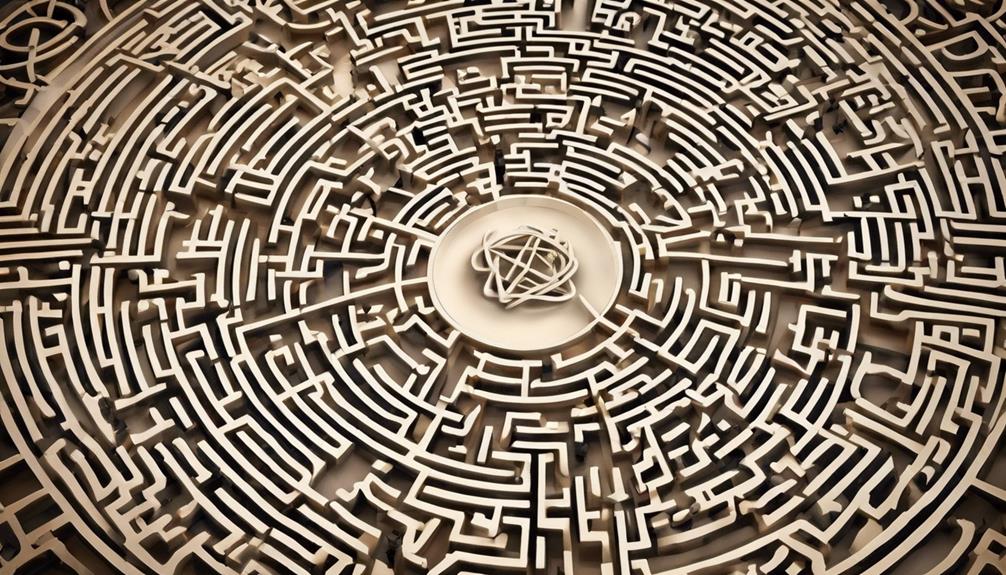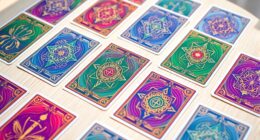Are you a fan of quick ways to personal growth? What if I told you there are 7 Enneagram Therapist Tips that could be the solution you’ve been looking for?
These insightful strategies cater to your unique Enneagram type, offering a roadmap towards self-discovery and growth.
Let's explore how these tips can unlock hidden potential and lead us on a path towards a more fulfilling existence.
Key Takeaways
- Embrace inner work to confront fears and foster self-awareness.
- Establish healthy boundaries for personal growth and self-care.
- Seek Enneagram therapist support for tailored coping strategies.
- Cultivate self-awareness and vibrant relationships for emotional well-being.
Understanding Enneagram Types
Understanding the Enneagram types is crucial for individuals seeking to delve into their core motivations and fears. Each Enneagram type possesses specific traits and behaviors that shape their interactions with the world. By comprehending these distinctions, one can gain insight into their own patterns of thinking and behaving. This knowledge serves as a foundation for self-awareness and personal growth, allowing individuals to navigate their inner landscape with clarity and purpose.
The Enneagram types are further categorized into three triads: the Instinctual/Gut, Feeling/Heart, and Head/Thinking centers. These triads offer a framework for understanding how individuals process information, make decisions, and approach challenges based on their dominant center. By recognizing which triad one falls into, they can begin to unravel the underlying motivations that drive their actions and uncover the fears that may be holding them back.
In essence, understanding the Enneagram types is a powerful tool for self-discovery and transformation. It provides a roadmap for exploring the depths of one's personality and offers a pathway towards personal evolution and fulfillment.
Embracing Inner Work

Delving into inner work requires a willingness to confront uncomfortable emotions and thoughts, fostering personal growth and self-awareness. By engaging in deep reflection and introspection, individuals can gain a better understanding of their emotional patterns and innermost selves. This process often involves facing fears, insecurities, and past traumas that may have been buried or ignored. Through this journey of self-discovery, healing can begin, leading to increased self-awareness and personal development.
Exploring inner work is a courageous step towards cultivating healthier relationships and improving overall well-being. As individuals delve into their innermost thoughts and feelings, they pave the way for authentic self-expression and a deeper connection with others. By embracing inner work, individuals set themselves on a path of self-reflection and growth that can positively impact various aspects of their lives. It's through this introspective journey that individuals can uncover hidden strengths, confront limiting beliefs, and ultimately transform themselves for the better.
Cultivating Self-Compassion
Confronting our innermost thoughts and emotions with kindness and understanding is the foundation for cultivating self-compassion. By acknowledging our imperfections without harsh self-criticism, we can foster a mindset of self-kindness and acceptance.
Research indicates that self-compassion is closely tied to emotional well-being and resilience, leading to reduced levels of anxiety and stress. This practice is especially beneficial for individuals of all Enneagram types who may struggle with recurring emotional patterns.
Embracing self-compassion involves incorporating mindfulness techniques, showing oneself the same care and empathy as offered to others, and recognizing our shared humanity in moments of difficulty.
Uncovering Core Motivations

Understanding our core motivations is key to unlocking the reasons behind our behaviors and decisions.
By identifying these inner drivers, we gain insight into our authentic needs and desires.
This awareness paves the way for personal growth and empowers us to make choices that align with our true selves.
Motivation Behind Behavior
Exploring the motivations driving our behaviors is a key aspect of unlocking personal growth through the Enneagram framework. Understanding the core desires that underlie our actions is essential for fostering self-awareness and facilitating personal development. The Enneagram system not only helps in identifying these motivations but also sheds light on the genetic and environmental factors shaping our behaviors. Through self-reflection guided by Enneagram insights, individuals can gain a deeper understanding of their behavioral patterns, leading to increased awareness and paving the way for meaningful behavioral changes. By delving into the roots of our motivations, we open up pathways for transformative growth and enhanced self-understanding.
| Motivation | Core Desires | Personal Growth |
|---|---|---|
| Genetic Factors | Environmental Factors | Self-Reflection |
| Behavioral Awareness | Enneagram Insights | Behavioral Change |
Identifying Inner Needs
By recognizing the inner needs specific to each Enneagram type, individuals can gain valuable insights into the core motivations driving their thoughts, feelings, and actions. Understanding these core motivations is crucial for personal growth and achieving emotional well-being. Here are four key points to consider:
- Enneagram Types: Each Enneagram type has distinct inner needs that influence their behavior.
- Core Motivations: Uncovering these inner needs helps in identifying the underlying driving forces behind actions.
- Self-Awareness: Recognizing one's inner needs fosters self-awareness and understanding of behavioral patterns.
- Fulfilling Inner Needs: Working towards fulfilling these inner needs is essential for achieving emotional well-being and personal development.
Developing Healthy Boundaries

Developing healthy boundaries requires clear communication of personal needs and limits to maintain emotional and physical well-being. In the realm of personal growth, setting boundaries is paramount. As Enneagram therapists, we understand the significance of boundaries in fostering respectful and balanced relationships. By recognizing and honoring our boundaries, we enhance self-respect and promote self-care. Establishing clear boundaries isn't only crucial for preventing burnout but also for nurturing healthy connections with others.
Effective boundary setting involves expressing our needs and limits assertively yet compassionately. It's essential to communicate openly with others about what's acceptable and what's not, creating a safe space for mutual understanding and respect. Healthy boundaries act as a protective shield, safeguarding our emotional well-being and preserving our energy. By prioritizing boundary setting in our relationships, we pave the way for authentic connections built on trust, understanding, and mutual support.
Integrating Growth Practices

Integrating growth practices into our daily routines can significantly enhance our personal development journey and foster a deeper sense of self-awareness and well-being. When we intentionally weave these practices into our lives, we create a nurturing environment for growth and self-discovery. Here are some key strategies to consider:
- Prioritize Self-Care: Allocate time each day for activities that rejuvenate your mind, body, and spirit, such as exercise, reading, or spending time in nature.
- Cultivate Mindfulness: Practice being present in the moment through meditation, deep breathing exercises, or mindful walks to enhance self-awareness and reduce stress.
- Invest in Professional Development: Enroll in courses, workshops, or seminars related to your interests or career goals to expand your knowledge and skills, fostering personal growth.
- Engage Body Intelligence: Connect with your body through practices like yoga, dance, or tai chi to deepen your understanding of physical sensations and emotions, promoting holistic growth.
Seeking Support and Guidance

To further enhance our personal growth journey, seeking support and guidance from Enneagram therapists can provide valuable insights and tools to address emotional challenges and deepen our self-understanding. Enneagram therapists, like Joanne B. Kim, LMFT, specialize in assisting individuals with specific Enneagram types such as 1, 2, 4, 9, and Highly Sensitive Persons.
Their expertise focuses on fostering vibrant relationships, empowerment, and understanding Enneagram coping strategies tailored to each type's needs. By participating in Enneagram retreats led by these professionals, individuals can experience healing, gain self-awareness, and foster personal growth under expert guidance.
Understanding Enneagram instincts and subtypes is crucial as it accelerates personal development and enhances emotional intelligence. By engaging with Enneagram therapists, we can explore our inner workings, develop effective coping mechanisms, and cultivate a deeper sense of self-awareness to navigate life's complexities with resilience and authenticity.
Frequently Asked Questions
How Do You Use the Enneagram for Personal Growth?
We utilize the Enneagram for personal growth by identifying our patterns and behaviors. This awareness allows us to make strategic changes for continuous development. Understanding our tendencies promotes self-awareness and guides us towards healthier behaviors.
Should Therapists Use Enneagram?
Therapists should use the Enneagram as a tool for deeper client understanding and tailored treatment plans. It enhances rapport, communication, and targeted support for personal growth. Enneagram-trained therapists can guide clients effectively.
Which Enneagram Loves Self Improvement?
We Enneagrams who love self-improvement are often Type 1s. We observe imperfections, strive for perfection, and value self-worth. Reflection on behaviors and incorporation of mindfulness and self-compassion practices aid our continuous growth.
Which Enneagram Is the Rarest?
As we delve into Enneagram wisdom, we discover Type 4, the Individualist, as the rare gem among personalities. Their depth and emotional richness make them stand out, yearning for genuine connections in a world of surface interactions.
Conclusion
In conclusion, incorporating the Enneagram therapist tips for personal growth can truly transform our lives.
By understanding our Enneagram type, embracing inner work, cultivating self-compassion, uncovering core motivations, developing healthy boundaries, integrating growth practices, and seeking support and guidance, we can embark on a journey of self-discovery and transformation.
These tips are like a magical elixir for our souls, guiding us towards a brighter, more fulfilling future.
Eugene brings a fresh, dynamic voice to our platform as one of our talented Writers. Specializing in research-driven content, he explores the latest findings in psychology and personal growth, translating them into actionable insights for our readers. Eugene’s work is fueled by a curiosity about what makes us tick and a desire to help others unlock their potential.










